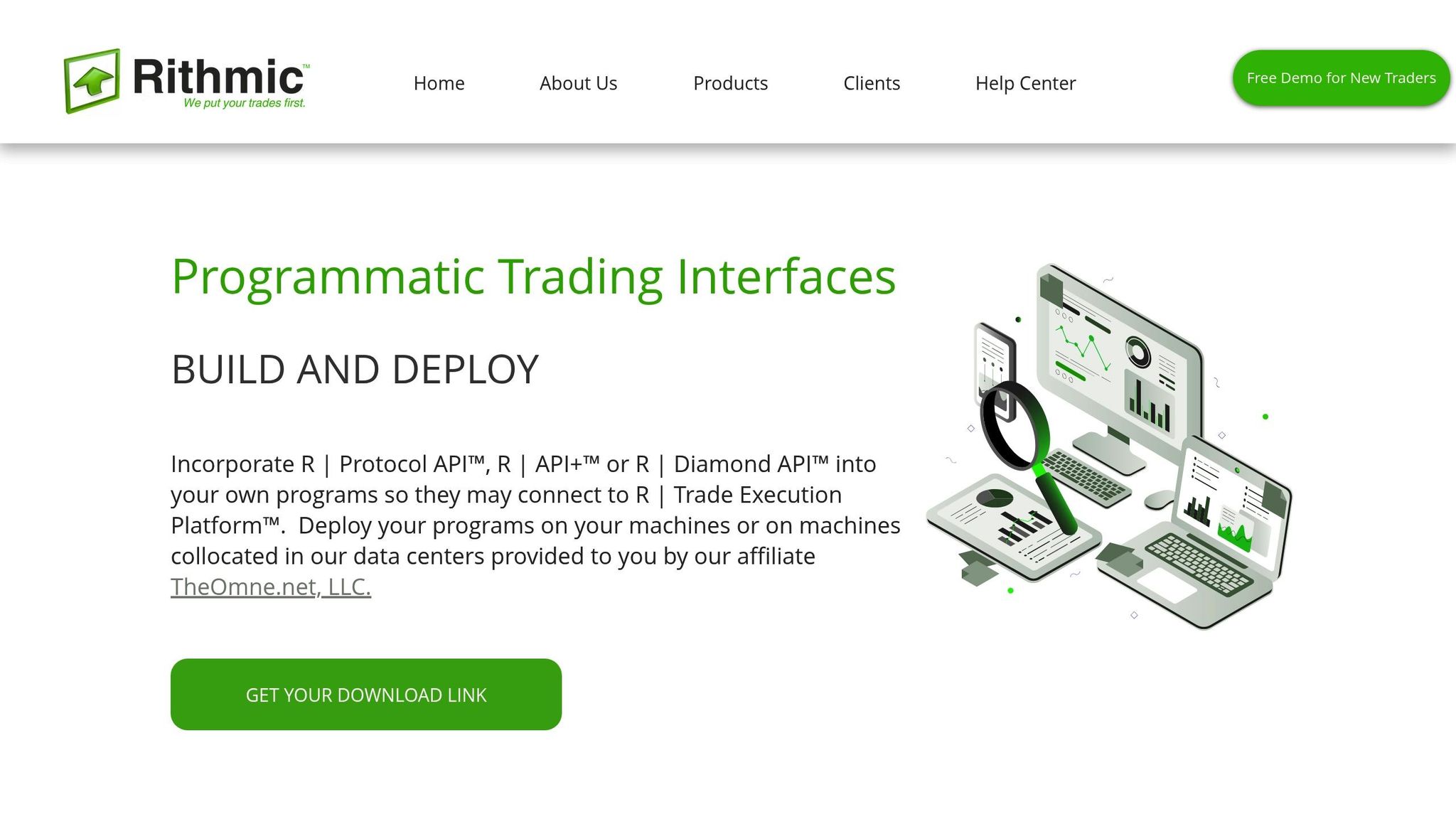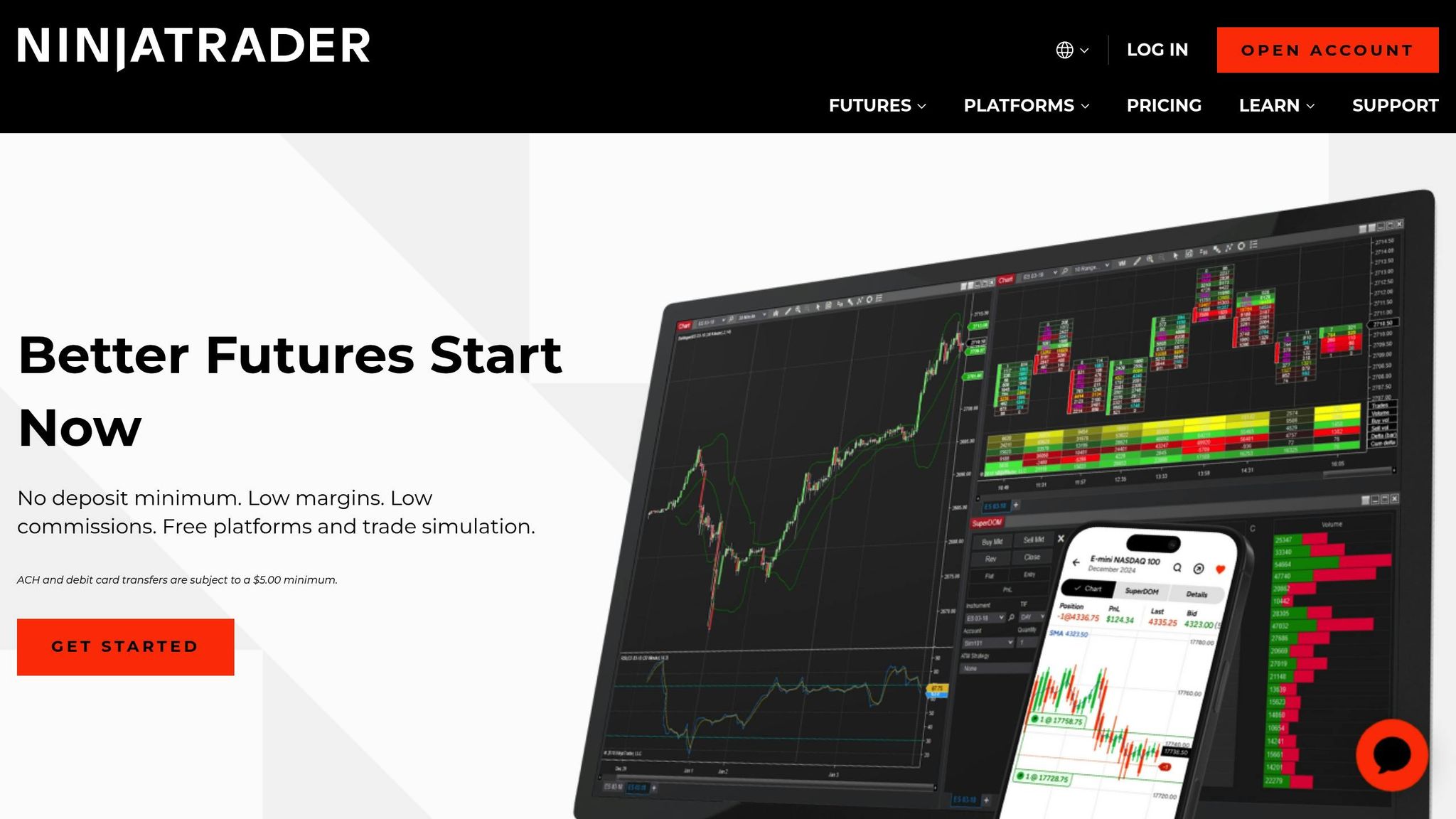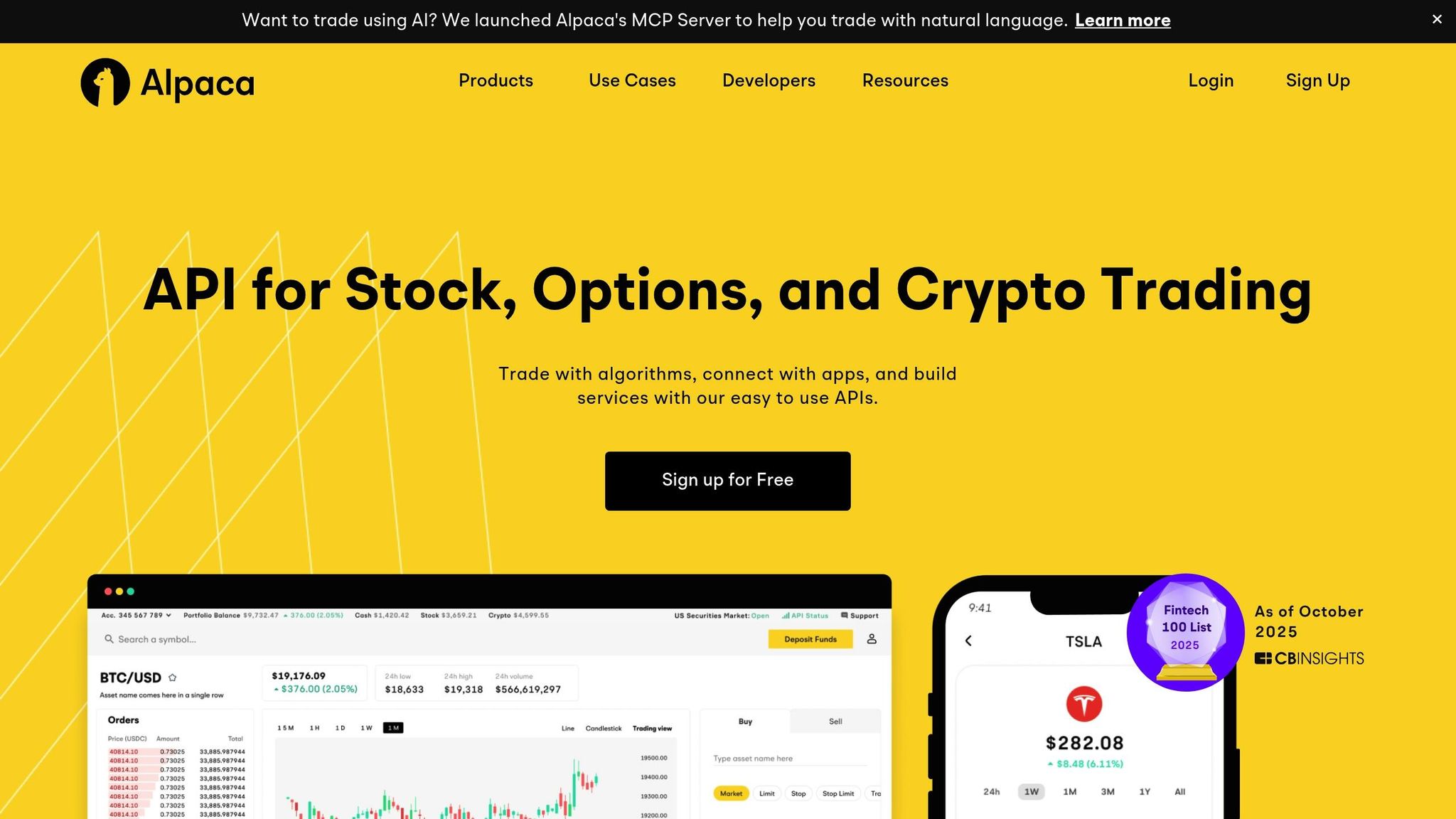When you’re selecting a futures trading API in 2025, speed, integration, and market access are key factors to consider. APIs serve as the backbone for algorithmic trading, connecting your strategies to the market for real-time data and order execution. Here’s a quick breakdown of the top five options:
- Rithmic API: Offers sub-millisecond latency, direct market access to major futures exchanges (CME, CBOT, NYMEX), and supports advanced order types. Ideal for high-frequency trading.
- TradeStation API: Combines strategy development, backtesting, and live trading in one platform. Features EasyLanguage for coding and provides extensive historical data for testing.
- Interactive Brokers TWS API: Supports multiple programming languages (Python, Java, C++, etc.) and connects to over 150 global exchanges, making it a versatile choice for multi-asset strategies.
- NinjaTrader Platform API: Focused on futures trading, it uses NinjaScript (C#) for deep strategy customization and offers advanced backtesting tools.
- Alpaca Trading API: A simpler, cloud-based option with Python support. While its futures capabilities are limited, it’s cost-effective for smaller-scale trading.
Quick Comparison
| Feature | Rithmic API | TradeStation API | Interactive Brokers TWS API | NinjaTrader Platform API | Alpaca Trading API |
|---|---|---|---|---|---|
| Latency | Sub-millisecond | Low to moderate | Moderate | Low | Moderate |
| Programming | C++, Java, .NET | EasyLanguage, Python | Python, Java, C++ | C#, NinjaScript | Python, JavaScript |
| Backtesting | Limited | Built-in tools | Historical data access | Advanced tools | Basic tools |
| Market Access | Major futures only | Stocks, futures, etc. | 150+ global exchanges | Futures, forex, stocks | Limited futures |
| Cost | Premium pricing | Account-based fees | Tiered commissions | Licensing fees | Commission-free |
The best API for you depends on your strategy, trading frequency, and budget. Test your choice on a small scale to ensure it meets your needs.
UNLOCK Pro Futures Trading: The Rhythmic API, Python & AI Path to HFT
1. Rithmic API

The Rithmic API is a high-performance tool tailored for institutional traders and advanced algorithmic strategies. It’s well-regarded in the futures trading world for its reliability and efficiency.
This API focuses on direct market access, connecting users to major futures exchanges like CME Group, CBOT, NYMEX, and COMEX. By offering this direct connection, it ensures precise timing and accurate execution – essential for strategies that rely on split-second order placements.
Latency Performance (in ms)
When it comes to latency, Rithmic delivers exceptional speed. It boasts sub-millisecond order execution, with round-trip times clocking in at under 0.5 milliseconds. This is achieved through optimized network protocols and dedicated connections to exchange matching engines. Such performance makes it a go-to choice for high-frequency trading and scalping strategies.
To maintain consistently low latency – even during periods of market volatility – Rithmic employs redundant data centers located near major exchanges and a proprietary network infrastructure.
Supported Asset Classes
Rithmic provides access to a broad range of futures markets, including equity indices, energy, agriculture, metals, and interest rates. Traders can operate across major contract months and access both standard and micro contracts, depending on their needs.
The API also supports options on futures trading, enabling complex strategies that combine futures and options positions. This versatility is especially useful for portfolio-based algorithms that span multiple commodity sectors and financial instruments.
2. TradeStation API
TradeStation provides a robust API and user-friendly development tools, making it a go-to choice for algorithmic traders who need both backtesting capabilities and live execution.
What sets TradeStation apart is its all-in-one approach to algorithmic trading. Instead of just providing raw API access, it offers an entire ecosystem where traders can design, test, and deploy their strategies smoothly. This integrated setup meets the demands of traders who require a streamlined process for creating and executing strategies quickly.
Programming Language Support
TradeStation’s core programming language is EasyLanguage, a proprietary scripting tool tailored specifically for trading applications. Its straightforward design allows traders to develop advanced systems, integrate custom indicators, and set up alerts with ease. By simplifying the coding process, EasyLanguage enables traders to focus more on refining their strategy rather than getting bogged down by technical complexities.
Backtesting and Historical Data Availability
The platform provides access to an extensive library of historical data, including U.S. and Eurex contracts, which is invaluable for thorough backtesting and fine-tuning strategies. Additionally, it supports walk-forward backtesting, enabling traders to evaluate their strategies under various market conditions and timeframes. This comprehensive data access helps ensure that algorithms perform reliably across different market cycles.
Supported Asset Classes
TradeStation’s API covers a wide range of asset classes, including futures, equities, and options. Traders can access markets ranging from stock indices and cryptocurrencies to metals, energy, and agricultural products. With its strong U.S. market presence, advanced analytics, and institutional-grade algorithms, the platform is well-suited for multi-asset trading strategies.
3. Interactive Brokers TWS API

The Interactive Brokers TWS API stands out with its support for multiple programming languages, including Python, Java, C++, C#, and Visual Basic. This flexibility allows developers to choose the language that aligns best with their trading strategies and technical expertise. Python is a favorite among many users thanks to its simple syntax and the vast range of libraries available, making it a go-to choice for efficient development. Meanwhile, the other supported languages cater to developers with more specialized needs or preferences. This broad language compatibility makes the TWS API a powerful tool for implementing advanced algorithmic trading strategies.
4. NinjaTrader Platform API

NinjaTrader provides an API tailored specifically for professional futures trading. It operates within a powerful C# environment and comes equipped with advanced tools for backtesting strategies.
Programming Language Support
The API is built around NinjaScript, a C#-based programming language. This allows traders to efficiently create and refine automated trading strategies.
Backtesting and Historical Data Availability
With the built-in Market Replay feature, traders can test their strategies using historical market data. This tool ensures thorough strategy validation before moving to live trading.
Supported Asset Classes
NinjaTrader supports futures, forex, and stocks. Its emphasis on futures trading makes it a go-to choice for professionals in that market.
5. Alpaca Trading API

The Alpaca Trading API provides access to futures trading capabilities. However, the publicly available information about its data services, execution methods, and integration options is somewhat sparse. For the most accurate and up-to-date details, it’s best to refer directly to Alpaca’s official documentation. This will help you determine whether it aligns with the needs of your automated trading system. This wraps up our overview of APIs before diving into a comparison of key metrics.
API Comparison Table
When choosing an API for algorithmic futures trading, understanding the technical factors that impact performance is crucial. Below is a comparison of five platforms, breaking down their key features to help you make an informed decision.
| Feature | Rithmic API | TradeStation API | Interactive Brokers TWS API | NinjaTrader Platform API | Alpaca Trading API |
|---|---|---|---|---|---|
| Latency | Ultra-low (sub-millisecond) | Low to moderate | Moderate | Low | Moderate |
| Programming Languages | C++, C#, .NET, Java | EasyLanguage, C#, Python | Java, C++, Python, C#, VB.NET | C#, NinjaScript | Python, C#, JavaScript |
| Backtesting Support | Limited native support | Built-in Strategy Testing | Historical data access | Advanced backtesting engine | Basic historical data |
| Real-time Data | Level II market data | Real-time quotes & charts | Comprehensive market data | Real-time and historical | Real-time market data |
| Order Types | Complex order types | Standard & advanced | Comprehensive order suite | Full order management | Basic order types |
| Asset Classes | Futures, options on futures | Stocks, options, futures, forex | Multi-asset global markets | Futures, forex, stocks | Stocks, crypto, limited futures |
| Market Centers | CME, CBOT, NYMEX, ICE | Multiple exchanges | Global exchanges (150+) | Major futures exchanges | US markets primarily |
| API Documentation | Comprehensive technical docs | Extensive with examples | Detailed reference guides | Well-documented with samples | Growing documentation |
| Cost Structure | Professional pricing | Account-based fees | Tiered commission structure | Platform licensing fees | Commission-free model |
| Deployment Options | On-premises, co-location | Cloud-based platform | Desktop & cloud solutions | Desktop platform | Cloud-native |
This table provides a snapshot of each API’s specifications, but let’s dive deeper into what sets these platforms apart.
Performance and Speed
Rithmic is the go-to choice for traders who prioritize speed, offering sub-millisecond latency ideal for high-frequency trading. By contrast, TradeStation provides a more user-friendly environment, perfect for retail traders looking to develop strategies with ease. Interactive Brokers stands out for its extensive market access, supporting over 150 global exchanges, making it a strong contender for diversified trading strategies.
Integration and Complexity
The ease of integrating these APIs varies. NinjaTrader’s NinjaScript allows for deep customization but comes with a steeper learning curve. On the other hand, Alpaca’s REST API is straightforward, especially for Python developers, though its futures trading capabilities are limited compared to platforms like Rithmic or NinjaTrader.
Data Quality and Backtesting
Data availability is a critical factor for accurate backtesting. TradeStation offers decades of historical data with tick-level precision, while Interactive Brokers supplements price data with detailed fundamental information. Rithmic focuses on real-time execution rather than providing extensive historical datasets, which could be a limitation for traders relying heavily on backtesting.
Cost Considerations
Costs can vary significantly across platforms. Rithmic’s ultra-low latency infrastructure comes at a premium, appealing to institutional traders, while Alpaca’s commission-free model is attractive for smaller-scale strategies. TradeStation and NinjaTrader strike a balance with moderate fees that align with their robust feature sets.
Scalability
Scalability becomes essential as trading volume increases. Rithmic and Interactive Brokers are well-suited for high-frequency strategies, offering the infrastructure needed for large-scale operations. Alpaca and TradeStation cater more to medium-frequency traders, while NinjaTrader is a strong option for retail traders but may face limitations with institutional-level volumes.
This comparison highlights the distinct strengths and trade-offs of each platform, helping you align your choice with your trading needs and goals.
Conclusion
Choosing the right API for your trading needs comes down to how well its features align with your specific goals. Key factors like speed, ease of integration, cost, and technical compatibility should guide your decision-making process.
Some APIs are designed for lightning-fast performance, making them perfect for high-frequency trading strategies. Others focus on offering intuitive interfaces and advanced backtesting tools, which can be a great fit for retail traders or Python developers. It’s also essential to weigh the cost structure and technical capabilities – low-latency, high-performance APIs suit demanding strategies, while user-friendly options might better serve simpler, retail-focused approaches.
Ultimately, the best API is one that complements your trading strategy, frequency, and budget. Before fully committing, test your chosen API on a smaller scale to ensure it meets your expectations. This methodical approach helps lay the groundwork for consistent and effective algorithmic trading as you move forward into 2025.
FAQs
What should algo traders look for in a futures trading API in 2025?
When choosing a futures trading API in 2025, algo traders need to focus on a few key features: real-time market data, smooth integration, and powerful tools that can elevate automated trading strategies. Look for an API that enables efficient backtesting, dependable real-time execution, and thorough data analysis to help fine-tune your performance.
It’s also crucial to check if the API works well with your current tech stack, comes with responsive customer support, and includes clear, easy-to-follow documentation. A thoughtfully designed API can make a noticeable difference in streamlining your trading operations and boosting profitability.
How does latency affect the performance of a futures trading API, and which API is best for high-frequency trading?
Latency is a key factor in how well a futures trading API performs, particularly for high-frequency trading where even a single millisecond can make a difference. Faster latency means quicker order execution and data processing, which can directly influence profitability in rapidly changing markets.
For traders who prioritize speed and reliability, selecting an API built for ultra-low latency and smooth real-time data delivery is crucial. Focusing on latency can help fine-tune your trading system, improving both performance and execution precision.
How does programming language support vary among the top futures trading APIs, and what impact does it have on developing trading strategies?
Programming language options can differ widely across futures trading APIs, and this plays a big role in how easily traders can create and execute their strategies. Some APIs offer broad compatibility, supporting widely-used languages like Python, Java, and C++, while others might limit users to a single language or proprietary scripting tools.
For algorithmic traders, the programming language you work with can impact everything from development speed to the availability of useful libraries and how well the API integrates with your existing tools. For instance, Python is a go-to choice for many because of its simplicity and robust libraries for tasks like data analysis and machine learning. On the other hand, C++ is often preferred when performance and speed are critical. Choosing an API that supports your preferred language can make your development process smoother and help you build and test strategies more efficiently.








